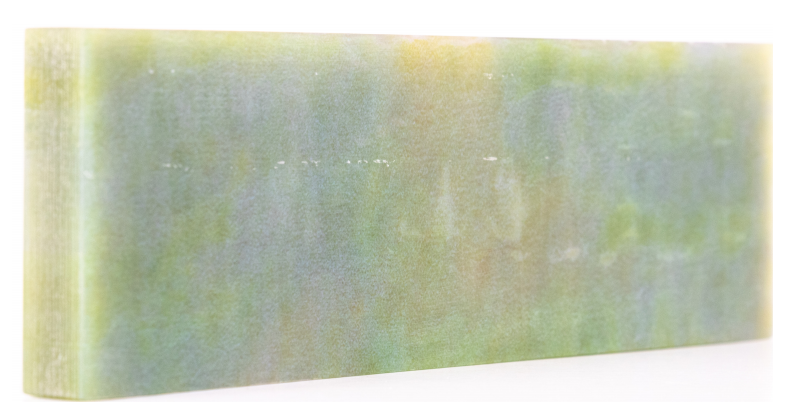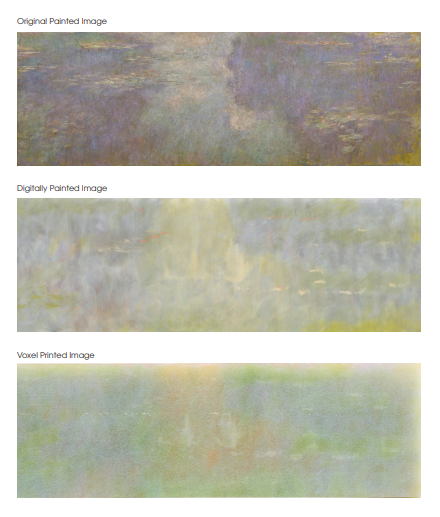Victoria University of Wellington masters’ student Joseph Coddington has carried out a project which looks at how voxel 3D printing can be used to approach research with a design focus and creative output, as opposed to considering new advances in technology from a solely technical angle.
To demonstrate his approach, Coddington used voxel 3D printing to replicate a single panel from artist Claude Monet’s Waterlillies collection – a series of paintings created by the artist between 1914-26. Coddington chose Stratasys’ J750 3D printer to produce the prints, having first used Adobe’s Photoshop software to replicate the painting digitally.

Voxel 3D printing
In short, voxel printing enables users to define a color for each individual point – called voxels – throughout the whole volume of a model. Voxels are the 3D version of a pixel and the tiniest distinguishable element of a 3D object. During the voxel printing process, pixels are 3D printed with full color and selected material hardness capabilities.
Coddington previously conducted another project involving voxel 3D printing, which aimed to establish the technique as a new means of film capture and present an alternative to the .stl file. Through his experimentation, Coddington realized that by 3D printing film footage using voxel printing he could bring the process of film storage full circle.
As he described at the time, the project aimed to “show the new applications that voxel printing can offer” while showcasing the technique’s artistic qualities.
Elsewhere, voxel 3D printing has been explored by researchers at MIT’s Mediated Matter Group, who patented a method to translate point cloud data into a pixel-by-pixel approach for multimaterial 3D printing. Collaborating with Harvard University, the group demonstrated their method with the production of highly detailed anatomical models designed to give a better understanding of a patient’s condition.

Voxel printing Monet
When new 3D printing technologies emerge, Coddington has identified a tendency for research to focus significantly more on the technical aspects of the development and overshadow much of the creative element. He explains the rationale behind his approach to voxel 3D printing as a technique that can be used, “to further a connection between not just digital and physical worlds but between visual literacy and craft-based data.”
He continues: “Approaching research with a design focus allows me to generate new ideas applicable to the uniqueness and capabilities of new technology, in this case, 3D printing images such as paintings and using painting techniques to generate 3D printed images.”
To carry out his project, Coddington enlisted a Stratasys J750 3D printer. The award-winning J750 was initially launched in 2016 with the capability to mix and match full-color gradients for realistic 3D prints that do not require post-processing. Since then, the J750 has received several updates, including a medical upgrade in 2019 and expanded capabilities to include biomechanically accurate orthopedic applications at the tail end of last year.
Coddington chose to 3D print this particular panel of Monet’s Waterlillies paintings as there is justification to better show how light moves through the image than can be achieved through a 2D plane. By shining a light through his 3D printed image, Coddington could show a depth of dimension to the image that Monet couldn’t capture in his 2D painting.
“Pond water tends to be mirky with fragments of materials floating within,” he states in his project explanation. “These fragments appear at different depths when light shines through the body of water. Monet captures this sensation by layering his paints; however his image is still restricted to a 2D plane. Voxel printing can expose this 2D plane, and offer fragments of materials to be dispersed through the crafted object.
“When a backlight shines through the print we get a similar quality to light rays shining through a pond, as the light illuminates and is distorted by the material fragments.”

Coddington used computer-based editing software Adobe Photoshop to digitally replicate Monet’s approach to layering paint. He constructed 15 layers which each had color applied in a digitally improvised way based on observation of Monet’s work, which were then layered on top of each other. Then, Coddington used the J750 to 3D print the digital image.
“This research highlights the voxel printing method and provides a series of voxel prints which physically render the original digital image constructing its material output with the advantage of working within the digital realm,” he concludes. “The voxel printed designs, therefore, showcase the naked-eye or visual data of the original image and renders this object physically providing a bare-hand quality without nullifying its visual features.”
Subscribe to the 3D Printing Industry newsletter for the latest news in additive manufacturing. You can also stay connected by following us on Twitter and liking us on Facebook.
Be sure to subscribe to the Another Dimension podcast on your chosen podcast player to make sure you never miss an episode.
Looking for a career in additive manufacturing? Visit 3D Printing Jobs for a selection of roles in the industry.
Featured image shows the replica of Claude Monet’s Waterlillies via voxel 3D printing. Image via Joseph Coddington.


